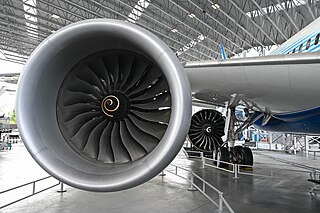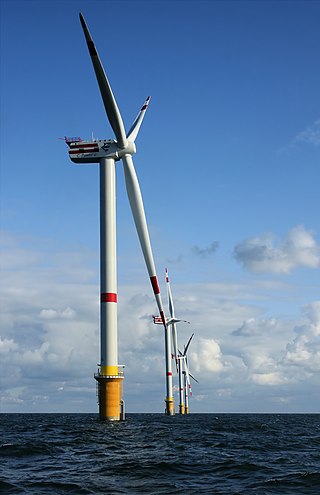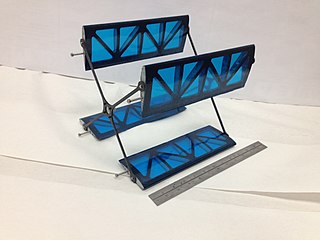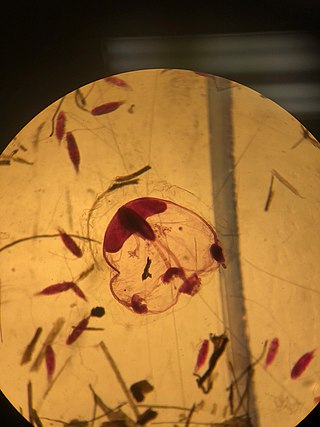
A vortex ring, also called a toroidal vortex, is a torus-shaped vortex in a fluid; that is, a region where the fluid mostly spins around an imaginary axis line that forms a closed loop. The dominant flow in a vortex ring is said to be toroidal, more precisely poloidal.
The vortex tube, also known as the Ranque-Hilsch vortex tube, is a mechanical device that separates a compressed gas into hot and cold streams. The gas emerging from the hot end can reach temperatures of 200 °C (390 °F), and the gas emerging from the cold end can reach −50 °C (−60 °F). It has no moving parts and is considered an environmentally friendly technology because it can work solely on compressed air and does not use Freon. Its efficiency is low, however, counteracting its other environmental advantages.

Jet propulsion is the propulsion of an object in one direction, produced by ejecting a jet of fluid in the opposite direction. By Newton's third law, the moving body is propelled in the opposite direction to the jet. Reaction engines operating on the principle of jet propulsion include the jet engine used for aircraft propulsion, the pump-jet used for marine propulsion, and the rocket engine and plasma thruster used for spacecraft propulsion. Underwater jet propulsion is also used by several marine animals, including cephalopods and salps, with the flying squid even displaying the only known instance of jet-powered aerial flight in the animal kingdom.

Turbomachinery, in mechanical engineering, describes machines that transfer energy between a rotor and a fluid, including both turbines and compressors. While a turbine transfers energy from a fluid to a rotor, a compressor transfers energy from a rotor to a fluid. It is an important application of fluid mechanics.

Roddam Narasimha FRS was an Indian aerospace scientist and fluid dynamicist. He was a professor of Aerospace Engineering at the Indian Institute of Science (1962–1999), director of the National Aerospace Laboratories (1984–1993) and the chairman of the Engineering Mechanics Unit at Jawaharlal Nehru Centre for Advanced Scientific Research. He was the DST Year-of-Science Chair Professor at JNCASR and concurrently held the Pratt & Whitney Chair in Science and Engineering at the University of Hyderabad. Narasimha was awarded the Padma Vibhushan, India's second-highest civilian award, in 2013. for his contributions to advance India's aerospace technology.

In aerodynamics, Betz's law indicates the maximum power that can be extracted from the wind, independent of the design of a wind turbine in open flow. It was published in 1919 by the German physicist Albert Betz. The law is derived from the principles of conservation of mass and momentum of the air stream flowing through an idealized "actuator disk" that extracts energy from the wind stream. According to Betz's law, no wind turbine of any mechanism can capture more than 16/27 (59.3%) of the kinetic energy in wind. The factor 16/27 (0.593) is known as Betz's coefficient. Practical utility-scale wind turbines achieve at peak 75–80% of the Betz limit.

The Gorlov helical turbine (GHT) is a water turbine evolved from the Darrieus turbine design by altering it to have helical blades/foils. Water turbines take kinetic energy and translate it into electricity. It was patented in a series of patents from September 19, 1995 to July 3, 2001 and won 2001 ASME Thomas A. Edison. GHT was invented by Alexander M. Gorlov, professor of Northeastern University.

The Windstar vertical-axis turbine is a lift-type device with straight blades attached at each end to a central rotating shaft. Windstar turbines were invented by Robert Nason Thomas and developed by Wind Harvest International, Inc., formerly the Wind Harvest Company, based in Point Reyes, California. Windstar turbines are operated as Linear Array Vortex Turbine Systems (LAVTS). Each rotor unit has a dual braking system of pneumatic disc brakes and blade pitch. All Windstar models use off-the-shelf generators, gearboxes, bearings and other components.
In fluid dynamics, flow can be decomposed into primary flow plus secondary flow, a relatively weaker flow pattern superimposed on the stronger primary flow pattern. The primary flow is often chosen to be an exact solution to simplified or approximated governing equations, such as potential flow around a wing or geostrophic current or wind on the rotating Earth. In that case, the secondary flow usefully spotlights the effects of complicated real-world terms neglected in those approximated equations. For instance, the consequences of viscosity are spotlighted by secondary flow in the viscous boundary layer, resolving the tea leaf paradox. As another example, if the primary flow is taken to be a balanced flow approximation with net force equated to zero, then the secondary circulation helps spotlight acceleration due to the mild imbalance of forces. A smallness assumption about secondary flow also facilitates linearization.
Specialized wind energy software applications aid in the development and operation of wind farms.

A wind turbine is a device that converts the kinetic energy of wind into electrical energy. As of 2020, hundreds of thousands of large turbines, in installations known as wind farms, were generating over 650 gigawatts of power, with 60 GW added each year. Wind turbines are an increasingly important source of intermittent renewable energy, and are used in many countries to lower energy costs and reduce reliance on fossil fuels. One study claimed that, as of 2009, wind had the "lowest relative greenhouse gas emissions, the least water consumption demands and the most favorable social impacts" compared to photovoltaic, hydro, geothermal, coal and gas energy sources.

The primary application of wind turbines is to generate energy using the wind. Hence, the aerodynamics is a very important aspect of wind turbines. Like most machines, wind turbines come in many different types, all of them based on different energy extraction concepts.
Victor Mikhailovitch Lyatkher (1933) was born in Kerch. He holds a Ph.D. in Engineering Science from the University of Leningrad and a doctorate in science from Moscow State University. Lyatkher is a professor, engineer, and inventor. Lyatkher has developed and patented numerous processes and machines. These deal mainly with renewable energy sources such as tidal power, water turbines, and vertical axis wind turbines. He developed a new method to forecast long-term variations in the Caspian Sea level, and designed a new kind of low head turbine. Mr. Lyatkher has worked for over thirty years in the wind and hydro-power industry. He has received several prizes and awards for his accomplishments, including the Prize of the Council of Ministers of the USSR, the Award of the Indian Society of Earthquake Technology, and five medals of the All Union USSR Exhibition, gold, silver and bronze.

A cyclorotor, cycloidal rotor, cycloidal propeller or cyclogiro, is a fluid propulsion device that converts shaft power into the acceleration of a fluid using a rotating axis perpendicular to the direction of fluid motion. It uses several blades with a spanwise axis parallel to the axis of rotation and perpendicular to the direction of fluid motion. These blades are cyclically pitched twice per revolution to produce force in any direction normal to the axis of rotation. Cyclorotors are used for propulsion, lift, and control on air and water vehicles. An aircraft using cyclorotors as the primary source of lift, propulsion, and control is known as a cyclogyro or cyclocopter. A unique aspect is that it can change the magnitude and direction of thrust without the need of tilting any aircraft structures. The patented application, used on ships with particular actuation mechanisms both mechanical or hydraulic, is named after German company Voith Turbo.
Vortex Bladeless Ltd. is a Spanish technology startup company that is developing a specific type of wind power generator that does not utilize rotating blades or lubricants, which more common wind turbines do use. Power instead is produced from resonant vibrations when wind passes through the turbine and is deflected into vortices in a process called vortex shedding.
Morteza (Mory) Gharib is the Hans W. Liepmann Professor of Aeronautics and Bio-Inspired Engineering at Caltech.

Nemopsis bachei is a species of relatively small gelatinous zooplankton hydrozoa found in both marine and estuarine environments. This particular species was first found and described by Louis Agassiz in 1849 from samples that were taken from the coast of Massachusetts. It was also noted and described in 1857 by another name off the coast of South Carolina.

A vertical-axis wind turbine (VAWT) is a type of wind turbine where the main rotor shaft is set transverse to the wind while the main components are located at the base of the turbine. This arrangement allows the generator and gearbox to be located close to the ground, facilitating service and repair. VAWTs do not need to be pointed into the wind, which removes the need for wind-sensing and orientation mechanisms. Major drawbacks for the early designs included the significant torque ripple during each revolution, and the large bending moments on the blades. Later designs addressed the torque ripple by sweeping the blades helically. Savonius vertical-axis wind turbines (VAWT) are not widespread, but their simplicity and better performance in disturbed flow-fields, compared to small horizontal-axis wind turbines (HAWT) make them a good alternative for distributed generation devices in an urban environment.
Homer Joseph "Stewie" Stewart was an American aeronautical engineer, rocket propulsion expert, and Caltech professor, who pioneered the first American satellites.

Clara O'Farrell is a guidance and control engineer for the Entry, Descent, and Landing (EDL) group at the NASA Jet Propulsion Lab who is known for her work on the Mars Perseverance Rover Mission. Her education and research in aerospace engineering focused in propulsion and fluid dynamics, leading her to work for NASA.













